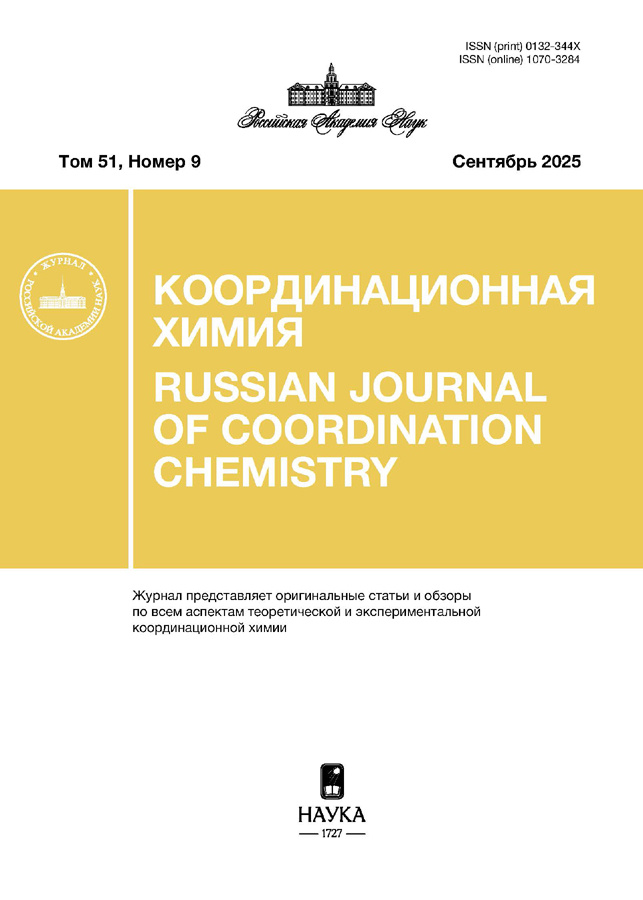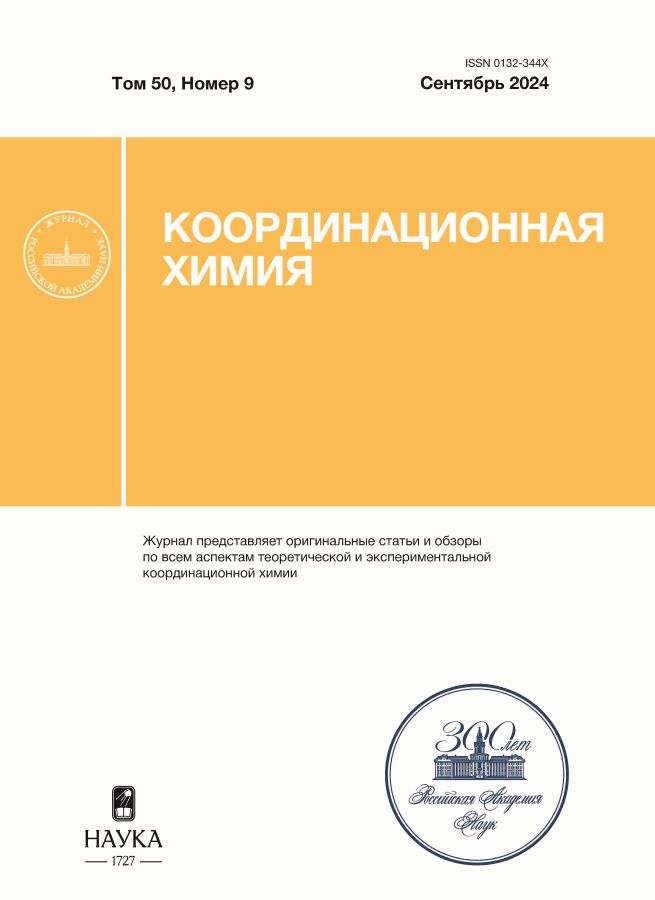Синтез, кристаллическая структура и магнитные свойства координационных полимеров кобальта(II) с 4,7-ди(1,2,4-триазол-1-ил)-2,1,3-бензотиадиазолом и ароматическими дикарбоновыми кислотами
- Авторы: Павлов Д.И.1,2, Лавров А.Н.2, Самсоненко Д.Г.2, Потапов А.С.1,2
-
Учреждения:
- Новосибирский национальный исследовательский государственный университет
- Институт неорганической химии им. А.В. Николаева СО РАН
- Выпуск: Том 50, № 9 (2024)
- Страницы: 577-591
- Раздел: Статьи
- URL: https://rjonco.com/0132-344X/article/view/667664
- DOI: https://doi.org/10.31857/S0132344X24090058
- EDN: https://elibrary.ru/LXMPNT
- ID: 667664
Цитировать
Полный текст
Аннотация
Взаимодействием нитрата кобальта(II) c 4,7-ди(1,2,4-триазол-1-ил)-2,1,3-бензотиадиазолом (Tr2btd) и ароматическими дикарбоновыми кислотами — терефталевой (H2bdc), 2,6-нафталиндикарбоновой (2,6-H2Ndc) и 2,5-фурандикарбоновой (2,5-H2Fdc) — синтезированы металл-органические координационные полимеры [Co(Tr2btd)(bdc)]n (I) и {[Co2(Tr2btd)(Dmf)(2,6-Ndc)2] · Dmf}n (II), имеющие слоистое строение, и цепочечный координационный полимер [Co(Tr2btd)2(H2O)(2,5-Fdc)]n (III). Соединения I и III являются парамагнитными в интервале температур 1.77–300 К без обменного взаимодействия между катионами Co2+, а в соединении II наблюдается антиферромагнитное взаимодействие между катионами Co2+ в биядерных строительных блоках с константой обменного взаимодействия J ≈ –100 К. При отборе проб для РСА были обнаружены единичные кристаллы фазы IIIa идентичного состава, но другого строения. Молекулярное строение координационных полимеров I, II, III, IIIa установлено с помощью РСА (CCDC № 2343141 (I), 2343297 (II); 2343296 (III); 2343140 (IIIa)).
Полный текст
Об авторах
Д. И. Павлов
Новосибирский национальный исследовательский государственный университет; Институт неорганической химии им. А.В. Николаева СО РАН
Email: potapov@niic.nsc.ru
Россия, Новосибирск; Новосибирск
А. Н. Лавров
Институт неорганической химии им. А.В. Николаева СО РАН
Email: potapov@niic.nsc.ru
Россия, Новосибирск
Д. Г. Самсоненко
Институт неорганической химии им. А.В. Николаева СО РАН
Email: potapov@niic.nsc.ru
Россия, Новосибирск
А. С. Потапов
Новосибирский национальный исследовательский государственный университет; Институт неорганической химии им. А.В. Николаева СО РАН
Автор, ответственный за переписку.
Email: potapov@niic.nsc.ru
Россия, Новосибирск; Новосибирск
Список литературы
- Агафонов М.А., Александров Е.В., Артюхова Н.А. и др. // Журн. структур. химии. 2022. Т. 63. № 5. С. 535 (Agafonov M.A., Alexandrov E.V., Artyukhova N.A. et al. // J. Struct. Chem. 2022, V. 63, P. 671). https://doi.org/10.1134/S0022476622050018
- Dybtsev D.N., Bryliakov K.P. // Coord. Chem. Rev. 2021. V. 437. P. 213845.
- You L.-X., Ren B.-Y., He Y.-K. et al. // J. Mol. Struct. 2024. V. 1304. P. 137687.
- Zhou H.C.J., Kitagawa S. // Chem. Soc. Rev. 2014. V. 43. P. 5415.
- Zhou W., Tang Y., Zhang X. et al. // Coord. Chem. Rev. 2023. V. 477. P. 214949.
- Efimova A.S., Alekseevskiy P.V., Timofeeva M.V. et al. // Small Methods. 2023. V. 7. P. 2300752.
- Wang W., Chen D., Li F., Xiao X., Xu Q. // Chem. 2024. V. 10. P. 86.
- Sun N., Yu H., Potapov A.S., Sun Y. // Comments Inorg. Chem. 2024. V. 44. P. 203.
- Коваленко К.А., Потапов А.С., Федин В.П. // Успехи химии. 2022. Т. 91. № 4. RCR5026. (Kovalenko K.A., Potapov A.S., Fedin V.P. // Russ. Chem. Rev. 2022. V. 91. RCR5026). https://doi.org/10.1070/RCR5026
- Yuvaraj A.R., Jayarama A., Sharma D. et al. // Int. J. Hydrogen Energy. 2024. V. 59. P. 1434.
- Thorarinsdottir A.E., Harris T.D. // Chem. Rev. 2020. V. 120. P. 8716.
- Shuku Y., Suizu R., Tsuchiizu M., Awaga K. // Chem. Commun. 2023. V. 59. P. 10105.
- Demakov P.A., Kovalenko K.A., Lavrov A.N., Fedin V.P. // Inorganics. 2023. V. 11. P. 259.
- Dubskikh V.A., Lysova A.A., Samsonenko D.G. et al. // Molecules. 2021. V. 26. P. 1269.
- Du M., Li C.-P., Liu C.-S., Fang S.-M. // Coord. Chem. Rev. 2013. V. 257. P. 1282.
- Pramanik B., Sahoo R., Das M.C. // Coord. Chem. Rev. 2023. V. 493. P. 215301.
- Pavlov D.I., Ryadun A.A., Potapov A.S. // Molecules. 2021. V. 26. P. 7392.
- Pavlov D.I., Yu X., Ryadun A.A. et al. // Food Chem. 2024. V. 445. P. 138747.
- Pavlov D.I., Yu X., Ryadun A.A., Fedin V.P., Potapov A.S. // Chemosensors. 2023. V. 11. P. 52.
- Хисамов Р.М., Конченко С.Н., Сухих Т.С. // Журн. структур. химии. 2022. Т. 63. № 12. P. 104047. (Khisamov R.M., Konchenko S.N., Sukhikh T.S. // J. Struct. Chem. 2022. V. 63. P. 2113). https://doi.org/10.1134/S0022476622120228
- Khisamov R.M., Ryadun A.A., Konchenko S.N., Sukhikh T.S. // Molecules. 2022. V. 27. P. 8162.
- Khisamov R.M., Sukhikh T.S., Konchenko S.N., Pushkarevsky N.A. // Inorganics. 2022. V. 10. P. 263.
- Сухих Т.С., Огиенко Д.С., Баширов Д.А., Конченко С.Н. // Изв. АН. Сер. хим. 2019. Т. 68. № 4. С. 651 (Sukhikh T.S., Ogienko D.S., Bashirov D.A., Konchenko S.N. // Russ. Chem. Bull. 2019. V. 68. P. 651). https://doi.org/10.1007/s11172-019-2472-9
- Katlenok E.A., Kuznetsov M.L., Semenov N.A. et al. // Inorg. Chem. Front. 2023. V. 10. P. 3065.
- Radiush E.A., Wang H., Chulanova E.A. et al. // ChemPlusChem. 2023. V. 88. Art. e202300523.
- Федоров М.С., Филиппов И.А., Гиричева Н.И. и др. // Журн. структур. химии. 2022. Т. 63. № 11. 102145 (Fedorov M.S., Filippov I.A., Giricheva N.I. et al. // J. Struct. Chem. 2022. V. 63, P. 1872). https://doi.org/10.1134/S0022476622110178
- Chernick E.T., Abdollahi M.F., Tabasi Z.A. et al. // New J. Chem. 2022. V. 46. P. 572.
- Yao S.L., Wu R.H., Wen P. et al. // J. Mol. Struct. 2024. V. 1297. 136925.
- Cao X.Q., Wu W.P., Li Q. et al. // Dalton Trans. 2022. V. 52. P. 652.
- Li L.-Q., Yao S.-L., Tian X.-M. et al. // CrystEngComm. 2021. V. 23. P. 2532.
- Yao S.L., Xiong Y.C., Tian X.M. et al. // CrystEngComm. 2021. V. 23. P. 1898.
- Jin J.K., Wu K., Liu X.Y. et al. // J. Am. Chem. Soc. 2021. V. 143. P. 21340.
- Song C., Ling Y., Jin L. et al. // Dalton Trans. 2015. V. 45. P. 190.
- Wu K., Liu X.-Y., Cheng P.-W. et al. // J. Am. Chem. Soc. 2023. V. 145. P. 18931.
- Wu K., Jin J.K., Liu X.Y. et al. // J. Mater. Chem. C 2022. V. 10. P. 11967.
- Sheldrick G.M. SADABS. Program for Empirical X-ray Absorption Correction. 2005.
- Svetogorov R.D., Dorovatovskii P.V., Lazarenko V.A. // Cryst. Res. Technol. 2020. V. 55. P. 1900184.
- Lazarenko V.A., Dorovatovskii P.V., Zubavichus Y.V. et al. // Crystals. 2017. V. 7. P. 325.
- Kabsch W. // Acta Crystallogr. D. 2010. V. 66. P. 125.
- Kabsch W. // Acta Crystallogr. D. 2010. V. 66. P. 133.
- CrysAlisPro. Agilent Technologies, Version 1.171.34.49 (release 20-01-2011 CrysAlis171 .NET).
- Sheldrick G.M. // Acta Crystallogr. A. 2015. V. 71. P. 3.
- Sheldrick G.M. // Acta Crystallogr. C. 2015. V. 71. P. 3.
- Healy C., Patil K.M., Wilson B.H. et al. // Coord. Chem. Rev. 2020. V. 419. P. 213388.
- Boča R. // Coord. Chem. Rev. 2004. V. 248. P. 757.
- Yue Q., Gao E.-Q. // Coord. Chem. Rev. 2019. V. 382. P. 1.
- Abasheeva K. D., Demakov P. A., Polyakova E. V. et al. // Nanomaterials. 2023. V. 13. P. 2773.
Дополнительные файлы




















